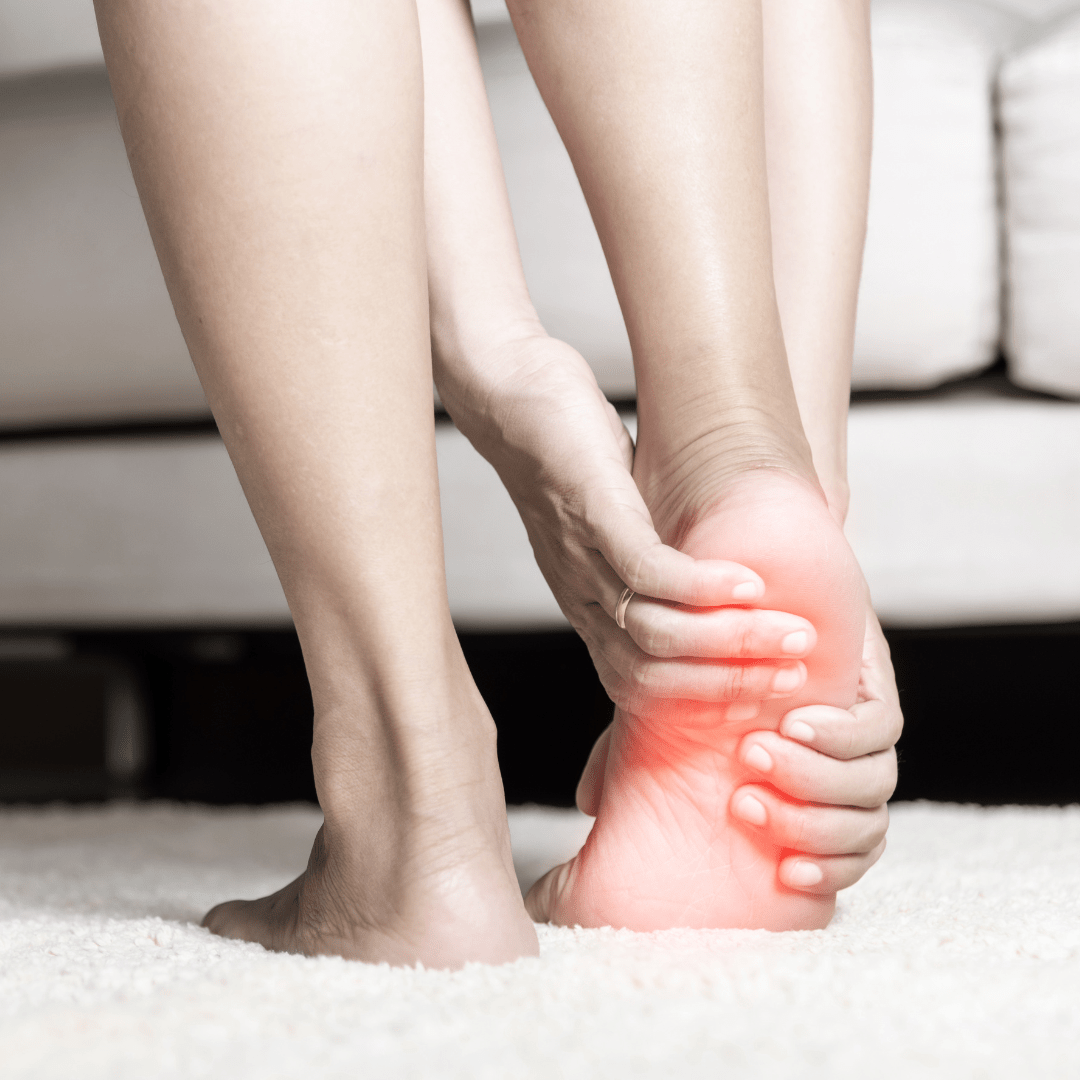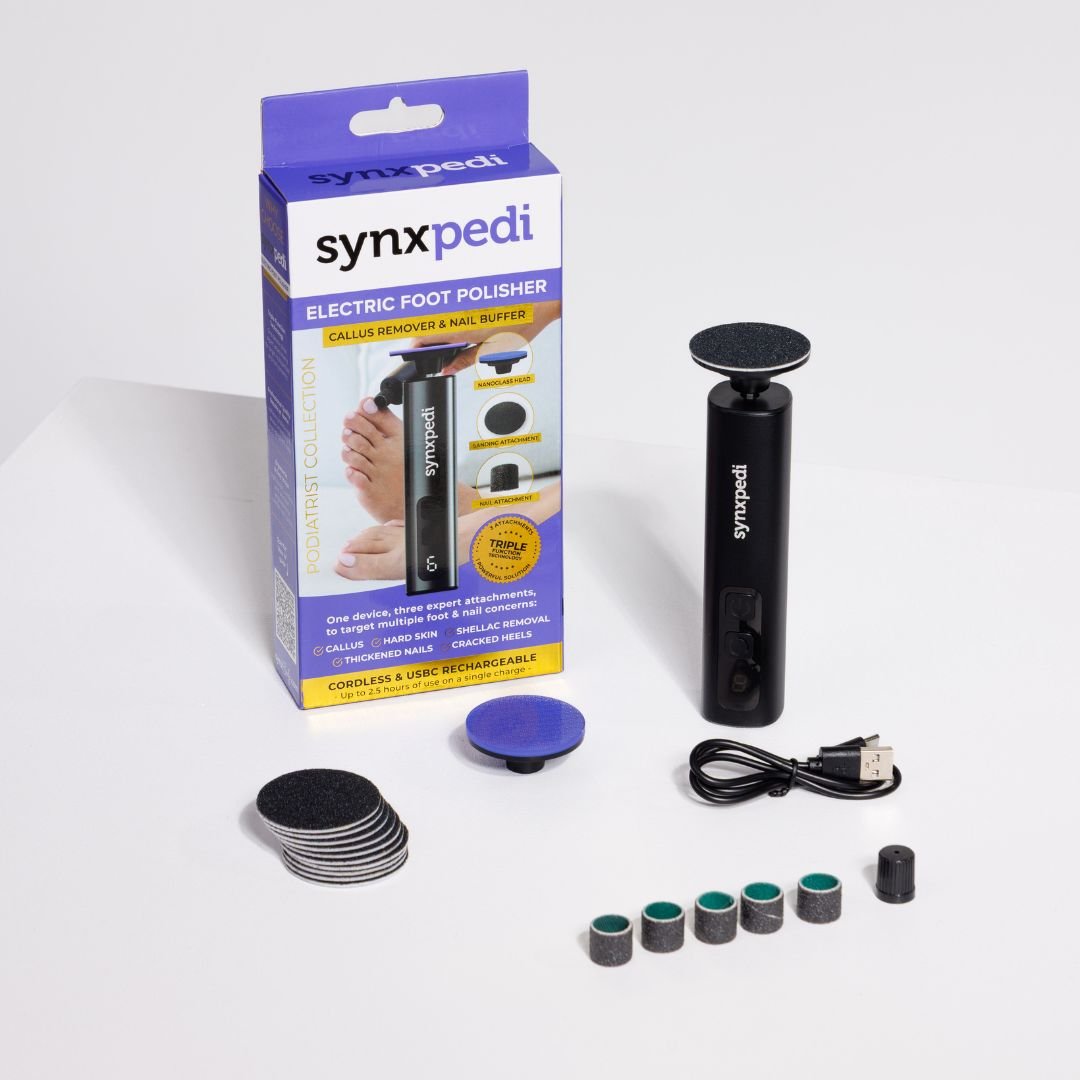What is plantar fasciitis?
The most common cause of heel pain in Australia is plantar fasciitis (say PLAN-tar fashy-EYE-tuss). It all comes down to the ligament that runs from your heel bone and along the sole of your foot to support your arch. While the plantar fascia ligament is very strong, it is still a ligament like any other and over-straining can make it:
- weak
- tender
- swollen
- irritated
- painful
- thickened
- tight
However, unlike many other ligaments, the plantar fascia is crucial to standing and walking, meaning it is under strain much of the time. As such, undue heel pain during or following normal standing and walking is one of the leading symptoms of plantar fasciitis.

How common is plantar fasciitis?
Very common, 1 in 10 people will develop plantar fasciitis in their lifetime. With simply standing and walking as a cause, it's no surprise plantar fasciitis is so common – especially in middle-aged people and people of any age who are on their feet a lot such as military personnel, athletes, hospital staff and tradesmen.
Another reason plantar fasciitis is so common is because there are so many factors that can contribute to its development. Everything from your gait, ankle strength, body weight, exercise level and choice of footwear can play a role. And, as often, simply ageing itself grants no favours to our bones and joints.
How do I tell if I have plantar fasciitis?
Some sufferers get plantar fasciitis in both feet, others just one – either way there is a classic set of symptoms. Do any of these sound like you?
- You’ve just woken up and as you get out of bed you find the first steps to be unusually painful
- You’re watching a movie on the couch with your feet up, when you stand up as the credits roll you find your feet are aching and stiff
- You’ve been on your feet at work for a few hours and as the day goes on the pain not only mounts but accelerates
- You go about your daily life with mild foot pain that gets much, much worse when you climb stairs
- You go jogging and you have some heel pain, but it seems to go away as you warm up only to return with a vengeance when your session is over

Why does plantar fasciitis present like this?
As a condition that is inflammatory in nature, as we rest or put our feet up, our inflammatory cells and fluid travel to the damaged area to assist in tissue repair and when we suddenly get up the fluid disperses, putting increased pressure around our nerves and causing intense pain for the first few steps.
As a condition that gradually intensifies, plantar fasciitis pain often accumulates as people go about their daily routines of activity and rest. They are unaware their feet need more rest than they are getting and continue to push through causing further damage.
It is almost like each day's activities make the plantar fasciitis a little worse and each night's healing doesn't quite catch up. Over time, this healing gap widens until the pain intensifies and in many cases becomes more chronic.
However, it is not practical to totally avoid standing and walking. The approach many people instinctively adopt is changing the way they walk, this, however, can lead to even worse problems as it can throw out the precise bio-mechanical balance of proper walking.
It's a recipe for further complications, including leg, hip, knee, ankle and back pain. This is how plantar fasciitis, through its knock-on effects, can drastically hamper a normal active life.
If plantar fasciitis goes untreated long enough, it can even lead to skeletal changes such as a heel spur. Clearly visible on X-rays, this bone growth extending from the heel at the anchor point of the plantar fascia ligament, is thought to develop in response to the constant strain.
Factors contributing towards plantar fasciitis
In normal walking, your plantar fascia ligament stretches every time your foot strikes the ground. Add in a repeated stressor and it means the ligament becomes weak, swollen, and irritated (inflamed). It may hurt for the entire time you are on your feet.
Risk factors for developing plantar fasciitis include:
- Feet that roll in too much (pronation/flat feet)
- Feet that roll out too much (supination/high arches)
- Walking, standing or running for long periods
- Being overweight – Places excess strain on muscles and joints
- Suddenly gaining weight – This can be due to pregnancy or any rapid weight gain which puts sudden stress on the plantar fascia
- Wearing shoes that don't fit well – if shoes are too small, the foot can become cramped which can effect muscle function and lead to increased pressure under the arch. At the same time, shoes that are too big can encourage the muscles of the foot to work harder to hold the foot in the shoe which can also lead to excess strain under the arch of the foot
- Wearing shoes that are worn out – If shoes are worn out they can place the foot in an abnormal position, changing the way we walk and putting extra strain on surrounding muscles and ligaments
- Tight Achilles tendons, reduces the amount of movement at the ankle joint and therefore increases the strain through the plantar fascia
- Tight calf muscles – lead to a shortened calf muscle, less movement at the ankle joint and increased stress under the arch of the foot
- Trigger Points - Trigger points are a knot or irritable spot in muscle or soft tissue due to overuse, injury or exertion. We often have many trigger points through out our body
- Repetitive overuse (sports or activities)
- A foot injury
- Inversion/eversion ankle sprain

PLANTAR FASCIITIS TREATMENT
Stages of treatment
Plantar fasciitis is almost always treatable. There are three phases:
- Relieve symptoms to address the pain and inflammation.
- Promote full healing through addressing the causes of the plantar fascial strain.
- Preventative measures to ensure the plantar fascia ligament is not further damaged, including improving the strength and flexibility and correcting foot problems.
If you suffer from plantar fasciitis you may find that moving through the three stages of treatment can take up to a year. Yes, this is a long time, however 95 percent of people either recover from or are able to manage the condition without surgery and in most cases with the right treatment and advice the symptoms can reduce much sooner than a year.
Moving through the phases of treatment
Because plantar fasciitis has many possible causes (often more than one at a time) and because everyone's feet are different the mix of treatment measures and their effectiveness is never the same from case to case. This does however give medical professionals a lot of options to work with. Surgery is always the last resort.
Footwear
Because plantar fasciitis is often caused by how you walk, it follows that what you walk in is important. Choosing the right footwear, orthotic inserts and supportive strapping or taping can improve the way you walk through changing the alignment and pressure on your joints. This alone can be highly effective in reducing plantar fasciitis strain and pain.
Selecting Footwear
There are 4 important factors to remember when shoe shopping:
- The back of the shoe’s heel must be firm and strong. You should not be able to bend the heel counter (back of the shoe) with your thumb when pressing firmly in this area.
- The middle of the shoe must not be able to be bent in half or folded in the midline of the shoe.
- The toe of the shoe must bend for lift off during gait.
- The shoe must have laces, velcro or retainers for support. Elastic is not recommended as this stretches over time resulting in more movement and instability unless the elastic can be tightened such as our Synxlace elastic no tie shoelaces.
Foot and Ankle Compression Sleeves
Compression sleeves help to reduce swelling and pain in the heel and arch area which aids in tissue repair. Synxplus Foot and Ankle sleeves are a great example and although tight, they slip on much like a sock and can be worn around the house and under shoes and socks as well as to bed to assist in repair and recovery.

Acupuncture and dry needling for plantar fasciitis
This technique involves the gentle insertion of fine acupuncture needles into the tight or spasmed muscles or soft tissue to reduce tension and tightness in the tissue. This technique is also referred to as dry needling or trigger point release. Used in many fields, acupuncture and dry needling are quite similar in overall concept, yet they differ in approach and theory. Nevertheless, many people find one or both effective in relieving plantar fasciitis pain.
Fig 1.
Fig 1. This diagram shows trigger points marked with an 'X' in the Abductor Hallucis muscle located in the arch of the foot which can often contribute to heel pain and plantar fasciitis.
Plantar fasciitis and remedial massage
Massage of the muscles in the foot and calf is often highly effective in addressing heel pain because the pain is often referred from muscles in the calf or elsewhere in the leg. Massage is also one of the most common treatments.
Laser therapy
Treating plantar fasciitis with lasers involves using low-powered pulses to reduce both pain and inflammation. The lasers then improve circulation which promotes tissue recovery.
Injections of corticosteroids
Corticosteroids are powerful anti-inflammatory agents that can be injected to specifically target problem areas. While slightly invasive and unpleasant, it is nonetheless an effective and well-proven method to reduce plantar fasciitis pain and swelling.
Extracorporeal shockwave therapy for plantar fasciitis
Extracorporeal shockwave therapy (ESWT) works sending sonic impulses into the affected area. It can often help reduce plantar fasciitis symptoms in cases that have not responded to other treatments. This is a cutting-edge technique, so the limits of its effectiveness are still unknown. Research in focused ESWT (requires anaesthetic) and radial ESWT (no anaesthetic) are ongoing.
Prolotherapy for plantar fasciitis
In prolotherapy, a concentrated combination of dextrose (a naturally occurring form of glucose) and local anaesthetic is precisely injected into the affected tissue. These careful injections stimulate natural healing and growth on a cellular level.
Medications for plantar fasciitis
Painkillers are effective in treating the heel pain symptoms of plantar fasciitis; however, they mask the severity of the conditions and do nothing towards addressing its cause. Over-the-counter painkillers, such as ibuprofen, are usually enough to help with the pain and your doctor may also prescribe stronger anti-inflammatories.
PLANTAR FASCIITIS SURGERY
Can you have plantar fasciitis surgery?
Yes, but it is not common, statistics report only approximately 5% of cases require surgical intervention. While generally not a major procedure, plantar fasciitis surgery is usually the last resort after all other treatment avenues have been explored and the pain hampers your daily life.
As a mark of their reluctance for surgery, many doctors will attempt non-surgical treatments for at least 6 months before surgery is considered. Moreover, doctors also expect that non-surgical treatments can take up to 12 months to be fully effective.
What happens in plantar fasciitis surgery?
In the unusual case when plantar fascia surgery is undertaken, it will generally be a day surgery performed under local, rather than general, anaesthetic.
There are two main ways this procedure is carried out:
- Endoscopic surgery, in which the doctor inserts specialised instruments through small incisions below the ankle bone
- Open surgery, which involves a larger incision made either where the thick skin of the sole meets the thinner skin of the heel, or directly into the sole of the foot.
Main surgical procedures for plantar fasciitis
There are three main procedures in plantar fasciitis surgery:
- Plantar fascia release - a procedure that involves cutting part of the plantar fascial ligament to release tension and relieve the persistent inflammation. It is minimally invasive and usually done by endoscopy. Open surgeries are also carried out in rare cases.
- Heel spur removal – at the time of plantar fascia release surgery, some doctors also opt to remove the heel spur itself. In isolation, the spur is not usually a problem, but how it interacts with the ligament can cause problems. Heel spurs are generally quite small and the procedure is not significantly more involved than plantar fascia release.
- Stretching or loosening specific foot nerves – Stretching or loosening foot nerves is referred to as neurolysis and completely removing or severing certain nerves is called a neurectomy. Both techniques aim to reduce painful stimulus.
Orthotic treatment of plantar fasciitis
Common, quick and non-invasive, treating plantar fasciitis with insoles or orthotics is simple and effective. The insert in your shoe 'tunes' the bio-mechanical forces of your standing and walking to reduce tissue stress and improve the alignment of your joints, bones, muscles and tendons.
However, there are so many different kinds available that it's difficult to find the right type for your foot and specific case of plantar fasciitis. In general, there are three kinds of plantar fasciitis insoles.
Off-the-shelf orthotics
On the rack at a pharmacy or sports store is how most people encounter orthotics. Usually the people buying them have not sought professional advice and their inserts are not customised in any way. When shopping for these types of orthotics it is important to look for neutral orthotics such as Synxsole orthotics which are suited to both foot types i.e. those that roll in (pronation) and those that roll out (supination). Without professional advice, you want to reduce the risk of causing further damage by choosing an orthotic that is safe and gentle and does not press up too much into the delicate arch area especially given how tender and inflamed it can be with plantar fasciitis.
Off-the-shelf orthotics can be a great starting point for anyone suffering from heel and arch pain. If pain persists, you should always consult your podiatrist or health professional with the inserts you have purchased as in some cases these can be modified according to your needs.

Prefabricated foot orthotics
This type of orthotic is usually encountered via consultation with your podiatrist where they are carefully matched according to your needs and foot type. Then they are quickly customised by a trained expert while you wait.

Casted customised orthotics
A casted orthotic is a one-off orthotic created specifically to treat your case of plantar fasciitis. These orthotics are prescribed after expert assessment by a podiatrist or health professional. As they are built from a cast of your actual foot, each is unique and offers the maximum effectiveness in treating your case.

FAQ's about plantar fasciitis
Does taping work on plantar fasciitis?
Yes, taping is an effective treatment of plantar fasciitis. Just like the huge range in orthotics, there are many types of taping techniques and each is highly customisable. Two of the most popular types of tape are:
- Rigid taping – A firm tape designed to restrict movement and is ideal for acute and extremely painful cases. Even though its adhesive is very strong, this tape must be replaced regularly and be kept dry when showering. The other negative is that it should not be used for long periods unless advised by your healthcare professional.
- Kinesiotaping – A flexible, stretchy tape that is designed to guide and assist joint movement and improve joint proprioception while also enabling full joint range of motion. Kinesiotaping generally lasts longer between applications and can be worn in the shower. There is a growing trend for this type of taping with the most popular tape on the market called Rocktape. Rocktape has strong adhesive and is hypoallergenic making it a safe and superior choice.

How did I get plantar fasciitis?
Plantar fasciitis can develop over time and not usually related to a single incident. Often, the root cause is the complex interaction of your entire biomechanical system – muscles, joints, bones, tendons and ligaments – as you go about everyday life. This, coupled with inappropriate footwear, increased activity or prolonged standing can exacerbate symptoms and lead to the condition.
That said, the appearance of plantar fasciitis pain can usually be traced to some ongoing change in your activities weeks or months beforehand. Perhaps you have been running more, trialing a new workout, gaining weight, walking barefoot on the beach, working long hours on your feet or climbing ladders – all can be risk factors in bringing a long-developing case of plantar fasciitis to the surface.
How long does it take for the heel pain to subside?
Plantar fasciitis is different for everyone, so the answer to how long the pain will take to respond to treatment is also different for everyone. Firstly, plantar fasciitis sometimes heals by itself. This is uncommon, most of the time the pain stabilises or decreases over time with the right treatment plan. In the best case scenario, full recovery can take approximately 6 weeks. Nonsurgical treatment can last up to a year although many cases can generally resolve after a six months.
Do I need custom orthotics to cure my plantar fasciitis?
Overwhelmingly, custom orthotics are not necessary to treat plantar fasciitis. If they are, it will be part of a multi-method treatment program that also addresses pain relief and prevention.
I have a heel spur, does that mean I have plantar fasciitis?
Maybe, but a heel spur is not always a problem by itself. In the past, heel spurs were thought to cause plantar fasciitis. These days, the opposite relationship is generally accepted: plantar fasciitis causes heel spurs. Even so, heel spurs, of themselves, often cause no problems or pain. In the case that a heel spur does need treatment, the approach is usually the same as treating plantar fasciitis.

Will a night splint help with my plantar fasciitis?
It certainly can, however there are no promises with plantar fasciitis. A night splint works by gently keeping the toes pulled back. This stretches the plantar fascia ligament and prevents it from contracting which generally occurs when we are resting and sleeping. Note: so long as you are lying down or seated, a night splint can also be worn in the daytime to give more consistent treatment.

Does pronation cause plantar fasciitis?
Sometimes. Pronation is the normal 'rolling in' movement of the ankle on each contact with the ground. It is necessary to reduce the shock of walking or running that is transferred to the joints of the knee, hip, pelvis and spine. While some pronation is necessary, some people pronate too much and this overstretches their plantar fascia ligament, leading to plantar fasciitis.
Should I stop exercising if I have plantar fasciitis?
No. Exercise is still a good idea and heel pain shouldn't stop you. It can however affect what exercises you do. Generally, you should dial back on the intensity of impact activities – such as jogging and walk – and try to introduce low-impact activities like swimming and pilates. It is also important to remember that weight gain from ceasing exercise can also have a negative affect in your recovery.
Why do I only have heel pain in one foot?
It is normal for each of your feet to be different slightly in size and also common for your legs to be different lengths which can affect the amount of time each heel has in contact with the ground . Further, as people have a naturally dominant leg, their feet are also different strengths. Thus, the way we move and how we distribute our weight is not actually in perfect balance. Over time, this difference can lead to one foot developing a condition, like plantar fasciitis, that the other is completely unaffected by.
Will my children get plantar fasciitis too?
Foot types do run in families so if your foot mechanics have played a part in your diagnosis then there is a chance your child may experience similar symptoms. Targeted early prevention can be undertaken which is good news. If your child has any signs of flat feet or high arches, Synxsole kids insoles have been designed to provide gentle arch support and reduce the stresses placed through the arch of the foot as well as being used as a preventative for foot complications. It is also vital to ensure your children have supportive shoes.
I hope you enjoyed my article on plantar fasciitis. You can find out more about the products we have to treat plantar fasciitis here: synxsole.com/collections.






